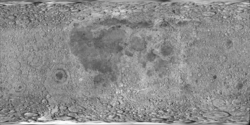| Henry (cráter lunar Apolo) Cráter lunar | ||
|---|---|---|
 Localización del cráter Henry en el valle Taurus-Littrow. El Macizo Sur aparece abajo a la izquierda, el Macizo Norte arriba en el centro, y Sculptured Hills arriba a la derecha. La barra de escala corresponde a 5 km | ||
| Coordenadas | 20°16′N 30°47′E / 20.27, 30.79 | |
| Diámetro | 300 m | |
| Epónimo | Designado por los astronautas | |
|
Localización sobre el mapa lunar | ||

Henry es el nombre oficioso de un cráter de la cara visible de la luna, localizado en el valle Taurus-Littrow, al pie de Sculptured Hills. Los astronautas Eugene Cernan y Harrison Schmitt alunizaron al suroeste de este cráter en 1972, en el transcurso de la misión Apolo 17.
 |
Henry se halla al noroeste de Shakespeare y de Van Serg, y al oeste de Cochise. La Estación Geológica 6 de la misión Apolo 17 se localiza al norte del cráter.
El nombre del cráter es informal y no ha sido reconocido por la Unión Astronómica Internacional (UAI), a pesar de que casi todas las otras denominaciones dentro del valle Taurus-Littrow utilizadas por los astronautas sí que lo han sido. Posiblemente esto se haya debido a que la UAI ya había reconocido un cráter con el nombre de Henry.[1] El cráter fue bautizado Henry por los astronautas conmemorando al príncipe portugués Enrique el Navegante.[2]
Referencias
- ↑ Henry crater, Gazetteer of Planetary Nomenclature, International Astronomical Union (IAU) Working Group for Planetary System Nomenclature (WGPSN)
- ↑ The Valley of Taurus-Littrow, Apollo 17 Lunar Surface Journal, Corrected Transcript and Commentary Copyright 1995 by Eric M. Jones
- (WGPSN), IAU Working Group for Planetary System Nomenclature (13 de febrero de 2013). «Gazetteer of Planetary Nomenclature. 1:1 Million-Scale Maps of the Moon» (en inglés). UAI / USGS. Consultado el 6 de abril de 2016.
- Andersson, L. E.; Whitaker, E. A., (1982). NASA Catalogue of Lunar Nomenclature (en inglés). NASA RP-1097.
- Blue, Jennifer (25 de julio de 2007). «Gazetteer of Planetary Nomenclature» (en inglés). USGS. Consultado el 2 de enero de 2012.
- Bussey, B.; Spudis, P. (2004). The Clementine Atlas of the Moon (en inglés). Nueva York: Cambridge University Press. ISBN 0-521-81528-2.
- Cocks, Elijah E.; Cocks, Josiah C. (1995). Who's Who on the Moon: A Biographical Dictionary of Lunar Nomenclature (en inglés). Tudor Publishers. ISBN 0-936389-27-3.
- McDowell, Jonathan (15 de julio de 2007). «Lunar Nomenclature» (en inglés). Jonathan's Space Report. Consultado el 2 de enero de 2012.
- Menzel, D. H.; Minnaert, M.; Levin, B.; Dollfus, A.; Bell, B. (1971). «Report on Lunar Nomenclature by The Working Group of Commission 17 of the IAU». Space Science Reviews (en inglés) 12: 136.
- Moore, Patrick (2001). On the Moon (en inglés). Sterling Publishing Co. ISBN 0-304-35469-4.
- Price, Fred W. (1988). The Moon Observer's Handbook (en inglés). Cambridge University Press. ISBN 0521335000.
- Rükl, Antonín (1990). Atlas of the Moon (en inglés). Kalmbach Books. ISBN 0-913135-17-8.
- Webb, Rev. T. W. (1962). Celestial Objects for Common Telescopes, 6ª edición revisada (en inglés). Dover. ISBN 0-486-20917-2.
- Whitaker, Ewen A. (2003). Mapping and Naming the Moon (en inglés). Cambridge University Press. 978-0-521-54414-6.
- Wlasuk, Peter T. (2000). Observing the Moon (en inglés). Springer. ISBN 1-85233-193-3.
- «Lunar Impact Crater Database» (en inglés). Lunar and Planetary Institute (USRA). Consultado el 12 de septiembre de 2017.









